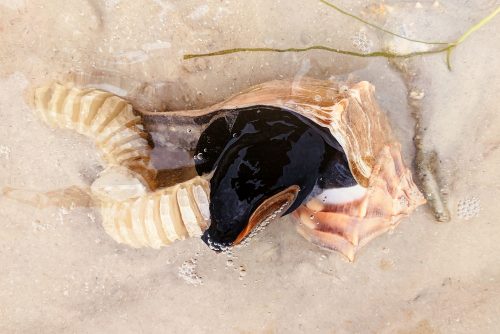In past newsletters we’ve reported on how essential the lightning whelk was for Calusa Indians. Recently, a photo of lightning whelks in waters near the Calusa Heritage Trail had us asking, “what are they doing?”.

Lightning whelks are persistent predators, feeding on two–shelled mollusks such as quahog clams. A whelk typically eats one bivalve in a month, taking several days to eat a large clam. They, in turn, are eaten by sea turtles, blue crabs and horse conchs. The photographed animals were not feeding.
Although little is known about lightning whelk reproduction, males have been observed around a female whelk during mating season. Steve Geiger, Research Scientist for the Florida Fish and Wildlife Research Institute, believes this to be a copulation event, in which multiple males provide sperm in a kind of packet or possibly to a receptacle vessel at the bottom of the foot. Geiger has seen up to four males with a female. Although he has found that there are often two presumptive males with one female, it isn’t always the case, he has also observed a single female laying eggs with no males present.
Once a female is fertilized, she lays her fibrous egg casing, a chain of up to 200 pouches each containing several dozen nearly microscopic juvenile whelks. She then attaches the chain to underwater plant sediment using a special gland on her foot.
The remarkable photograph shows a female lightning whelk laying her egg sac, with another whelk nearby, probably a male. We can’t help but imagine that the Calusa also witnessed mollusks mating asking, “what are they doing?” and, just like us, learned that life under the water is fascinating.